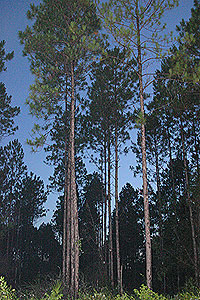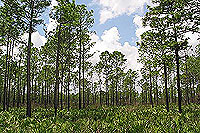|
History Animals & Plants Natural Communities Coastal Dry Uplands Upland Mesic Freshwater Marshes Forested Wetlands Fresh Water Estuaries |
Natural Communities and Habitats:
Upland Mesic Forests
In This Section:
Hardwoods | Pinelands
Hardwood and Mixed Pine-Hardwood Forests
 An upland hardwood forest at Three Rivers State Park (photo by Ray Moranz) |
These communities have served as refuges for northern plant species during eras when glaciers expanded and the climate was much colder. When the planet warmed up again, some plants expanded their ranges back north into the mountains. Thus, it's not surprising that north Florida boasts the southernmost occurrences of a number of plant species. Other species in North Florida mixed forests and hammocks are “disjunct,” that is, they have two or more populations separated by great distances. They also have “endemic” plant and animal species (that is, they are found nowhere else in the world), such as the Torreya tree, the Florida yew, and the fire-backed crayfish.
The mix of species changes over time. Pine may dominate in young stands, while in older stands, the hardwoods take over. The soil is rich in organic matter and usually has a thick topping of decaying leaves on the surface, which helps to hold on to moisture and provides nourishment for the fine roots of trees and shrubs. The trees form a nearly solid canopy, so not much light gets to the forest floor. It's shady and humid in the summer when all the trees are fully leafed out.(FWC 7 and 8)
Typical plants: southern magnolia, pignut hickory, sweetgum, sourwood, Florida maple, devil's walking stick, American beech, mockernut hickory, American hornbeam, redbud, flowering dogwood, Carolina holly, American holly, eastern hophornbeam, spruce pine, loblolly pine, shortleaf pine, live oak, swamp chestnut oak, white oak, laurel oak, southern red oak, water oak, partridgeberry, saw greenbrier, sarsaparilla vine, trilliums, silverbell, Christmas fern, witchhazel, redbud, mountain laurel, Carolina laurelcherry, Sebastianbush, fringe tree, bigleaf snowbell, tulip poplar, white ash, horse sugar
Typical animals include slimy salamander, bronze frog, spring peeper, box turtle, green anole, broadhead skink, ground skink, red-bellied snake, gray rat snake, rough green snake, eastern king snake, coral snake, southern copperhead, turkey, woodcock, barred owl, mourning dove, yellow-billed cuckoo, screech-owl, great horned owl, red-tailed hawk, common night hawk, ruby-throated hummingbird, red-bellied woodpecker, yellow-bellied sapsucker, downy woodpecker, pileated woodpecker, eastern phoebe, eastern kingbird, blue jay, tufted titmouse, Carolina chickadee, nuthatches, Carolina wren, hermit thrush, robin, brown thrasher, cedar waxwing, white-eyed vireo, red-eyed vireo, yellow-throated warbler, palm warbler, ovenbird, summer tanager, cardinal, rufous-sided towhee, white-throated sparrow, orchard oriole, opossum, gray squirrel, wood rat, cotton mouse, raccoon, gray fox, bobcat, and white-tailed deer.
Rare plants: Florida torreya, Ashe's magnolia, pyramid magnolia, fringed campion, Florida yew, Alabama spiny-pod, Florida spiny-pod, Flyr's brickell-bush, toothed savory, croomia, Carolina lily, silky camellia, narrow-leaved trillium, Florida flame azalea, corkwood
Rare animals: tiger salamander, Apalachicola dusky salamander, southern dusky salamander, fire-back crayfish, Say's spiketail
Where to see it:
Apalachee Wildlife Management Area
Apalachicola Bluffs and Ravines Preserve Garden of Eden trail
Florida Caverns State Park
Lake Talquin State Forest
St. Marks National Wildlife Refuge
St. Vincent National Wildlife Refuge
South Marianna Trail and Canoe Launch
Three Rivers State Park
Torreya State Park
Pinelands - Flatwoods and Plantations
 A pine plantation in Wakulla County (photo by Karla Brandt) |
Pine plantations can appear to be monotonous, with endless straight rows of skinny stems marching off into the distance with little growing underneath them. Natural flatwoods, on the other hand, are sprinkled with slightly higher, drier places, where the natural community is similar to scrub. Flatwoods also have slightly lower, wetter spots here and there. Some of these low spots have trees in them, and these trees could form an entirely different natural community, such as a cypress dome or a baygall. Some low spots do not have trees; they might be temporary ponds, which are vital for many flatwoods amphibians; or they might fill with peat and become bogs, which support an amazing collection of insect-eating plants. Streams bordered by cypress or by hardwoods snake through the flatwoods. There's a lot of habitat diversity in flatwoods where the drainage has not been altered.
Fire is a natural event in flatwoods. Before the Europeans came to North America, flatwoods are thought to have burned every 1 to 8 years. Without regular fire, hardwoods take over and block the sunlight from reaching the ground, shading out the ground-hugging shrubs and nonwoody plants and changing the pine flatwoods into a hardwood forest.
 Typical mesic pine flatwoods with saw palmetto (photo by Brenda Herring) |
Typical plant groups: slash pine with saw palmetto, gallberry, fetterbush, wax myrtle, and rusty lyonia; longleaf with wiregrass and runner oak. Other pines in the ARROW region: loblolly pine, sand pine, pond pine, shortleaf pine, spruce pine. Typical flatwoods nonwoody species include St. Johns-wort, dwarf huckleberry, blueberry, bog buttons, blackroot, yellow-eyed grass, and cutthroat grass. In wetter flatwoods, typical plants include pond pine, slash pine, sweetbay, spikerush, beakrush, sedges, gallberry, titi, and saw palmetto.
Typical animals: oak toad, little grass frog, narrowmouth toad, black racer, red rat snake, brown-headed nuthatch, pine warbler, cotton rat, cotton mouse, black bear, raccoon, gray fox, bobcat, and white-tailed deer.
Rare plants: St. John's black-eyed Susan, panhandle spiderlily, West's flax, Florida waxweed, Florida skullcap, white-top pitcherplant, white birds-in-a-nest, Chapman's rhododendron, scare-weed, pine-woods aster, Apalachicola dragon-head, Florida beargrass, incised groove-bur, and Barbara's buttons
Rare animals: Bachman's sparrow, flatwoods salamander, Florida pine snake, indigo snake, red-cockaded woodpecker, Rafinesque's big-eared bat, southeastern bat, swallow-tailed kite
Where to see it:
Apalachicola National Forest
Edward Ball Wakulla Springs State Park
Florida Caverns State Park
Lake Talquin State Forest
Ochlockonee River State Park
St. Joseph Bay State Buffer Preserve
St. Marks National Wildlife Refuge
Tate's Hell State Forest
Three Rivers State Park
T.H. Stone Memorial St. Joseph Peninsula State Park
Torreya State Park
Wakulla State Forest
Note: The content of the website has not been updated since 2005. The site remains online for it's value as legacy content and is unlikely to be updated.